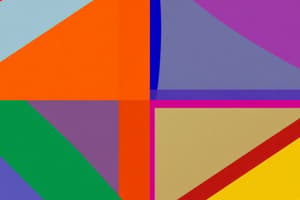Podcast
Questions and Answers
A quadrilateral is a parallelogram if both pairs of opposite angles are congruent.
A quadrilateral is a parallelogram if both pairs of opposite angles are congruent.
True (A)
A quadrilateral is a parallelogram if pairs of consecutive angles are supplementary.
A quadrilateral is a parallelogram if pairs of consecutive angles are supplementary.
True (A)
A quadrilateral is a parallelogram if the diagonals bisect each other.
A quadrilateral is a parallelogram if the diagonals bisect each other.
True (A)
A quadrilateral is a parallelogram if each diagonal divides a parallelogram into two congruent triangles.
A quadrilateral is a parallelogram if each diagonal divides a parallelogram into two congruent triangles.
A quadrilateral is a parallelogram if one pair of opposite sides are congruent and parallel.
A quadrilateral is a parallelogram if one pair of opposite sides are congruent and parallel.
In a parallelogram, any two opposite sides are congruent.
In a parallelogram, any two opposite sides are congruent.
In a parallelogram, any two consecutive angles are supplementary.
In a parallelogram, any two consecutive angles are supplementary.
The diagonals of a parallelogram bisect each other.
The diagonals of a parallelogram bisect each other.
A diagonal of a parallelogram forms two congruent triangles.
A diagonal of a parallelogram forms two congruent triangles.
Flashcards
Opposite Angles of Parallelogram
Opposite Angles of Parallelogram
Opposite angles in a parallelogram are equal.
Opposite Sides of Parallelogram
Opposite Sides of Parallelogram
In a parallelogram, opposite sides have equal lengths.
Consecutive Angles in Parallelogram
Consecutive Angles in Parallelogram
Consecutive angles in a parallelogram add up to 180 degrees.
Congruent Triangles via Diagonal
Congruent Triangles via Diagonal
Signup and view all the flashcards
Parallelogram Diagonals
Parallelogram Diagonals
Signup and view all the flashcards
Parallelogram - Opposite Sides Congruent
Parallelogram - Opposite Sides Congruent
Signup and view all the flashcards
Parallel Sides in Parallelogram
Parallel Sides in Parallelogram
Signup and view all the flashcards
Parallelogram - Supplementary Angles
Parallelogram - Supplementary Angles
Signup and view all the flashcards
Parallelogram - Opposite Angles Congruent
Parallelogram - Opposite Angles Congruent
Signup and view all the flashcards
Parallelogram - Bisecting Diagonals
Parallelogram - Bisecting Diagonals
Signup and view all the flashcards
Study Notes
Conditions for a Parallelogram
- A quadrilateral is a parallelogram if both pairs of opposite sides are congruent.
- A quadrilateral is a parallelogram if both pairs of opposite angles are congruent.
- A quadrilateral is a parallelogram if pairs of consecutive angles are supplementary.
- A quadrilateral is a parallelogram if the diagonals bisect each other.
- A quadrilateral is a parallelogram if each diagonal divides the parallelogram into two congruent triangles.
- A quadrilateral is a parallelogram if one pair of opposite sides are congruent and parallel.
Properties of a Parallelogram
- In a parallelogram, any two opposite sides are congruent.
- In a parallelogram, any two opposite angles are congruent.
- In a parallelogram, any two consecutive angles are supplementary.
- The diagonals of a parallelogram bisect each other.
- A diagonal of a parallelogram forms two congruent triangles.
Studying That Suits You
Use AI to generate personalized quizzes and flashcards to suit your learning preferences.
Related Documents
Description
This quiz covers the essential conditions and properties that define a parallelogram in geometry. Understand the characteristics that determine whether a quadrilateral is a parallelogram and explore the unique properties that apply to these shapes. Test your knowledge with questions focused on identifying and applying these principles.




